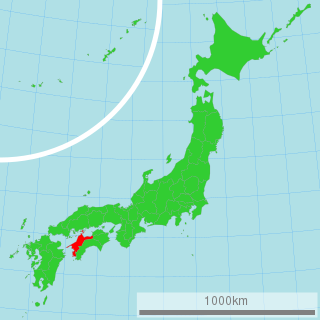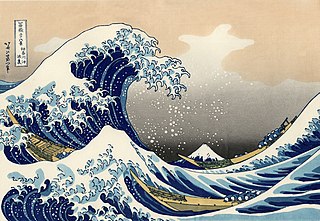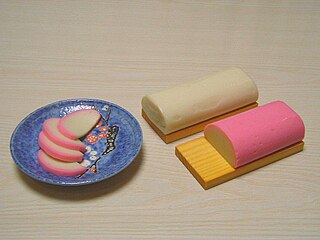
Kamaboko (蒲鉾:かまぼこ) is a type of cured surimi, a processed seafood product common in Japanese cuisine.

Uwajima is a city located in Ehime Prefecture, Japan.

Yawatahama is a city located in the southwestern part of Ehime Prefecture, Japan, and has the largest fish market on Shikoku. The Mikan is the featured agricultural product.
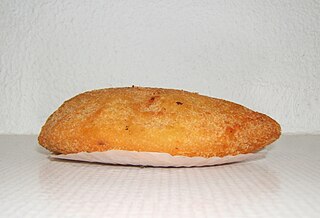
A rissole is a large circular ball, enclosed in pastry or rolled in breadcrumbs, usually baked or deep fried. It is filled with savory ingredients, most often minced meat or fish, and is served as an entrée, main course, or side dish. Rissoles originated in Portugal.
Sri Lankan cuisine has been shaped by many historical, cultural and other factors. Contact with foreign traders who brought new food items, cultural influences from neighbouring countries as well as the local traditions of the country's ethnic groups among other things have all helped shape Sri Lankan cuisine. Influences from Indian, Indonesian and Dutch cuisines are most evident with Sri Lankan cuisine sharing close ties to other neighbouring South and Southeast Asian cuisines. Today, some of the staples of Sri Lankan cuisine are rice, coconut and spices. The latter are used due to the country's history as a spice producer and trading post over several centuries.

Fish balls are a dish in China, notably popular in southern China, Hong Kong, Macau, as well as in parts of Southeast Asia, and among the overseas Chinese communities. They are made with fish paste and boiled in a soupy broth, or deep fried. They are also common in Nordic countries.

Nian gao, sometimes translated as year cake or Chinese New Year's cake, is a food prepared from glutinous rice flour and consumed in Chinese cuisine. While it can be eaten all year round, traditionally it is most popular during Chinese New Year. It is considered good luck to eat nian gao during this time, because nian gao is a homonym for "higher year." The Chinese word 粘 (nián), meaning "sticky", is identical in sound to 年, meaning "year", and the word 糕 (gāo), meaning "cake" is identical in sound to 高, meaning "high or tall". As such, eating nian gao has the symbolism of raising oneself taller in each coming year. It is also known as a rice cake. This sticky sweet snack was believed to be an offering to the Kitchen God, with the aim that his mouth will be stuck with the sticky cake, so that he can't badmouth the human family in front of the Jade Emperor. It is also traditionally eaten during the Duanwu Festival.

Kofta is a family of meatball or meatloaf dishes found in the Indian subcontinent, South Caucasian, Middle Eastern, Balkan, and Central Asian cuisines. In the simplest form, koftas consist of balls of minced or ground meat—usually beef, chicken, lamb, or pork—mixed with spices and/or onions. In the Indian subcontinent and the Middle East, koftas are usually made from lamb, beef, mutton or chicken, whereas Greek, Cypriot, and Balkan versions may use pork, beef, lamb, or mixture of the three. In India, vegetarian varieties include koftas made from potato, calabash, paneer, or banana. In Europe, kofta is often served in a fast-food sandwich in kebab shops.

Ugandan cuisine consists of traditional and modern cooking styles, practices, foods and dishes in Uganda, with English, Arab, and Asian influences.

Lebanese cuisine is a Levantine style of cooking that includes an abundance of whole grains, fruits, vegetables, starches, fresh fish and seafood; animal fats are consumed sparingly. Poultry is eaten more often than red meat, and when red meat is eaten, it is usually lamb on the coast, and goat meat in the mountain regions. It also includes copious amounts of garlic and olive oil, often seasoned by lemon juice. Chickpeas and parsley are also staples of the Lebanese diet. Lebanese cooking derives its style from various influences, such as Turkish, Arab, and Mediterranean cuisines.

A fishcake is a food item similar to a croquette, consisting of filleted fish or other seafood with potato patty, sometimes coated in breadcrumbs or batter, and fried.

Satsuma-age (薩摩揚げ) is a fried fishcake from Kagoshima, Japan. Surimi and flour is mixed to make a compact paste that is solidified through frying. It is a specialty of the Satsuma region. It is called tsuke-age in Kagoshima and known as chiki-agi in Okinawa.

Shumai is a type of traditional Chinese dumpling, originating from Huhhot. In Cantonese cuisine, it is usually served as a dim sum snack. In addition to accompanying the Chinese diaspora, a variation of Shaomai also appears in Japan and various Southeast Asian countries.
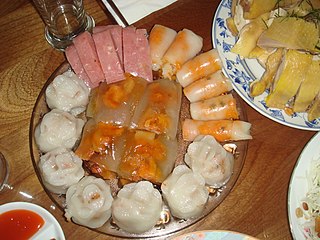
In Vietnamese, the term bánh translates loosely as "cake" or "bread", referring to a wide variety of prepared foods. With the addition of qualifying adjectives, bánh refers to a wide variety of sweet or savoury, distinct cakes, buns, pastries, sandwiches, and other food items, which may be cooked by steaming, baking, frying, deep-frying, or boiling. Foods made from wheat flour are generally called bánh, but the term may also refer to certain varieties of noodle and fish cake dishes, such as bánh canh and bánh hỏi.
The Uwajima Domain was a feudal domain in Iyo Province of Japan during the Edo period. It was ruled from 1608 to 1613 by the Tomita clan. After a brief period as Tokugawa-controlled tenryō territory, the domain passed into the hands of the Date clan. The founder was Date Hidemune (1591–1658), first-born son of Date Masamune (1567–1636). Date Hidemune could not inherit his father's position as head of the main Date clan because he was born by a concubine, so arrangements were made for Hidemune to hold this han, starting in 1615, at a far distance from the main Date clan holdings in northern Japan.

Nigerian cuisine consists of dishes or food items from the hundreds of ethnic groups that comprise Nigeria. Like other West African cuisines, it uses spices and herbs with palm or groundnut oil to create deeply flavored sauces and soups. Nigerian feasts are colourful and lavish, while aromatic market and roadside snacks cooked on barbecues or fried in oil are plentiful and varied.

Squid is eaten in many cuisines; in English, the culinary name calamari is often used for squid dishes but is also used for some octopus dishes as well, notably fried squid/octopus. There are many ways to prepare and cook squid, with every country and region having its own recipes. Fried squid appears in Mediterranean cuisine. In Lebanon, Syria and Armenia, it is served with a tarator sauce. In New Zealand, Australia and South Africa, it is sold in fish and chip shops. In North America, fried squid is a staple in seafood restaurants. In Britain, it can be found in Mediterranean 'calamari' or Asian 'salt and pepper fried squid' forms in all kinds of establishments, often served as a bar snack, street food or starter.
A great variety of cassava-based dishes are consumed in the regions where cassava is cultivated, and they include many national or ethnic specialities.
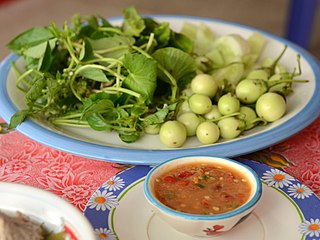
Nam phrik is a type of spicy chili sauce typical of Thai cuisine. Usual ingredients for nam phrik type sauces are fresh or dry chilies, garlic, shallots, lime juice and often some kind of fish or shrimp paste. In the traditional way of preparing these sauces, the ingredients are pounded together using a mortar and pestle, with either salt or fish sauce added to taste.

